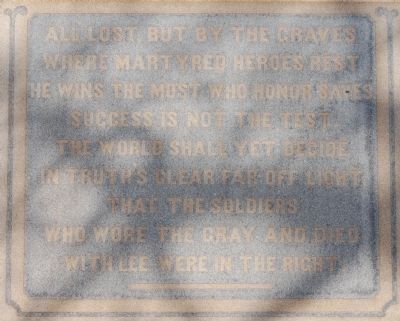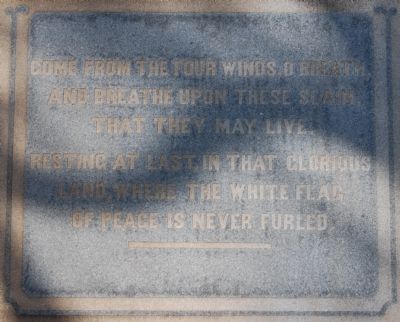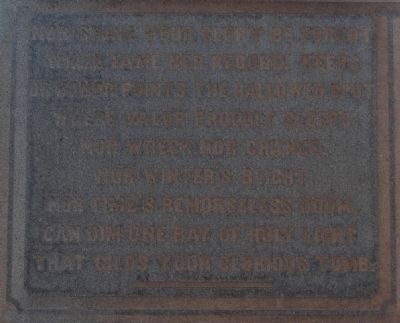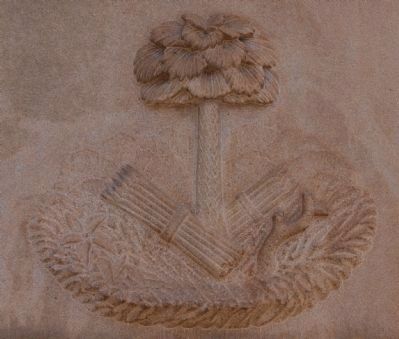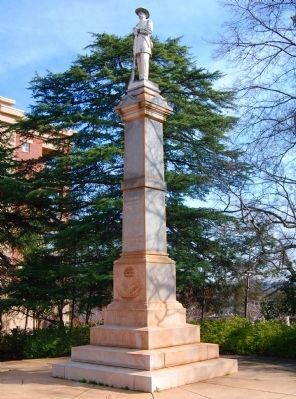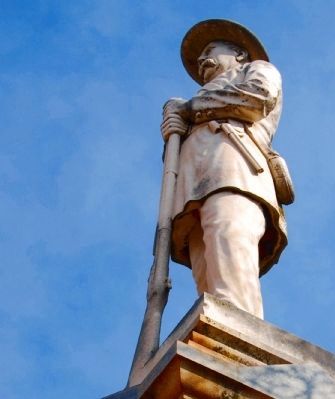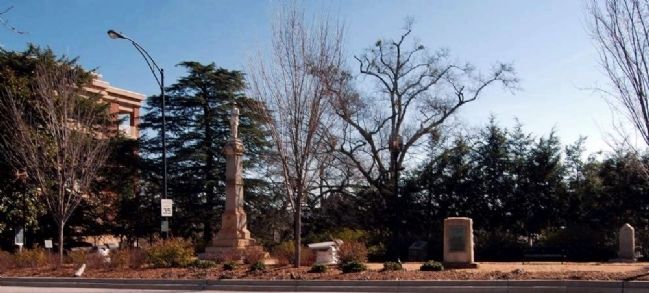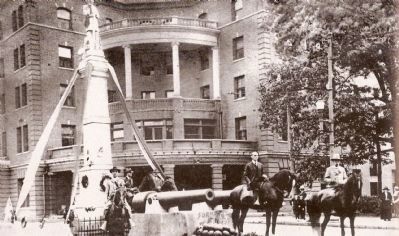Greenville in Greenville County, South Carolina — The American South (South Atlantic)
Greenville County Confederate Monument
Inscription.
[South Side]:
Where martyred heroes rest
He wins the most who honor saves
Success is not the test
The world shall yet decide
In truth's clear far off light
That the soldiers
Who wore the gray and died
With Lee, where right.
[East Side]:
And breathe upon these slain
That they may live.
Resting at last, in that glorious
Land, where the white flag
Of peace is never furled.
[North Side]:
While fame her record, keeps
Or honor points the hallowed spot
Where valor proudly sleeps,
Nor wreck, nor change,
Nor winter's blight,
Not time's remorseless doom,
Can dim one ray of holy light
That gilds your glorious tomb.
Erected 1892 by Ladies Memorial Association of Greenville County.
Topics. This historical marker and monument is listed in these topic lists: Heroes • Military • War, US Civil.
Location. 34° 51.3′ N, 82° 23.8′ W. Marker is in Greenville, South Carolina, in Greenville County. Marker is at the intersection of North Main Street and East Elford Street on North Main Street. Marker is located near the main entrance of Springwood Cemetery. Touch for map. Marker is in this post office area: Greenville SC 29601, United States of America. Touch for directions.
Other nearby markers. At least 8 other markers are within walking distance of this marker. General Robert E. Lee (a few steps from this marker); Eighty Unnamed Soldiers (a few steps from this marker); Mrs. James Williams (within shouting distance of this marker); Springwood Cemetery (within shouting distance of this marker); Kershaw Brigade (within shouting distance of this marker); Confederate Armory (within shouting distance of this marker); SC Ordinance of Secession (within shouting distance of this marker); In Memory of 81st Wildcat Division / Camp Sevier (within shouting distance of this marker). Touch for a list and map of all markers in Greenville.
More about this monument. James Ligon served as the model for the statue created by C.E. Kohlrus. The monument originally stood in the middle of Main Street in front of the Ottaray Hotel, now the site of the Hyatt Regency. [In 1924] the Confederate Monument moved to its present location to make way for the expansion of the downtown area and was re-dedicated. (Source: Springwood Cemetery: A Historic Tour, brochure by the Historic Greenville Foundation and City of Greenville Parks and Recreation available just inside the cemetery entrance.)
Additional commentary.
1. Greenville County Confederate Monument
The Ladies' Memorial Association of Greenville laid the cornerstone for this twenty-eight-foot monument on September 18, 1892 and unveiled it on September 27, 1892. Bishop Ellison Capers was the speaker for the cornerstone ceremony.
The cost of the monument was $1,000. C.F. Kohlrus, of Augusta, Georgia, sculpted the life-size bronze figure, which he modeled after a photograph of James Blackman Ligon, Greenville's former chief of police. Ligon, who was chosen because of his commanding figure and fine war record, was the first man to enlist in the Saluda Volunteers, Company G, 4th S.C. Volunteer Regiment. He rose to the rank of sergeant by the close of the war.
At the dedication, the orator was General Joseph B. Kershaw. James A. Hoyt, distinguished editor of the Greenville Mountaineer, delivered the dedicatory address. Hoyt, who was formerly a lieutenant in the Palmetto Riflemen, Company C, Palmetto Sharpshooters, said the monument represented the toil, devotion, fervor, and undying constancy of the noble women of the South. A large crowd turned out on dedication day, which was celebrated with a parade and marching bands. A contemporary photograph showed the Greenville monument in the center of North Main Street
just south of College Street, facing south. A wrought iron fence originally surrounded it. The War Department provided the two cannon, which arrived by railroad on August 11, 1900.
The Greenville monument had the dubious honor of setting the legal precedent concerning the removal of Confederate monuments that posed a hazard to traffic. As the horse and buggy gave way to the automobile, some city leaders began to consider the Greenville monument, resting in the middle of Main Street, a dangerous obstruction to traffic. In 1922, Greenville's city council decided to move the monument to the county courthouse, where it "will attract much more attention and be received as a desirable ornament." Confederate veterans, the United Daughters of the Confederacy, and the Confederate Memorial Association protested loudly. Before dawn on October 11, 1922, workmen arrived with a crane to move the monument. By 8:30 a.m., they had lifted the statue from its top. They also removed two blocks of the base to the courthouse plaza. When the workers returned from a break, the statue had disappeared. Before noon, four veterans, W.H. Cely, a private in Company F, Hagood's First S.C. Volunteer Regiment; Peter A. McDavid, a private in the Palmetto Rifles, Company B, 4th S.c. Volunteer Regiment and later lieutenant in Company L, 2nd Rifle Regiment, S.C. Volunteers; John T. Bramlett, a corporal in
the Davis Guards, Company F, Hampton Legion; and W.G. Grady obtained a temporary injunction forbidding the removal of the monument. Work ceased immediately. The base and statueless shaft remained in place for almost two years.
The Greenville Daily News said the statue had been "carefully stored away until the issue was settled." During the summer of 1923, word leaked out that the figure was hidden at a farm on Paris Mountain Road. It was quickly whisked away to a new hiding place in the Echols Street Fire Department. On July 26, 1923, Judge T.J. Mauldin issued an injunction chiding the city for not carrying the matter to a court initially to decide the issue. The case went to the state's Supreme Court. On June 9, 1924, it handed down a unanimous decision. For the traveling public's good, "the high purpose of honoring the Confederate dead could best be served by removing the monument from the center of a congested city street surrounded by the din and clamor of raucous automobile traffic where no one could pause to read the sermon in stone." The city government abandoned the decision to place the monument at the courthouse. Instead, a small park at the Springwood Cemetery was created by moving back the cemetery fence. On July 10, workmen started moving the monument to its new concrete base. By July 18, 1924, the figure was reunited with the monument and placed at
the newly created Monument Park.
The litigation surrounding the Greenville monument resulted in the transfer of monuments in Winnsboro, Spartanburg, Kingstree, Camden, Marion, Timmonsville, and Georgetown from their original locations in the middle of busy city streets to locations of less prominence. Counties and towns that placed their large monuments on courthouse lawns or town squares fared better-most remain in their original locations, generally in more prominent sections of town. Traffic still negotiates around the monument in Aiken, but it is the state's only large monument still standing in the middle of a prominent downtown intersection. (Source: A Guide to Confederate Monuments in South Carolina: "Passing the Silent Cup" by Robert S. Seigler (1997), pgs 359-361.)
— Submitted March 12, 2010, by Brian Scott of Anderson, South Carolina.
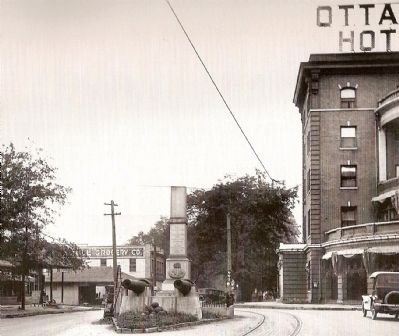
William B. Coxe Collection, Greenville County Historical Society, circa 1922
9. Greenville County Confederate Monument
In 1922, the statue was removed during discussions concerning relocation, following a period of confusion as to where to place it. For a while, the whereabouts of the statue were completely unknown. after the statue was discovered in a barn on a farm outside Greenville, it was replaced in 1924 and the statue moved to its present location outside Springwood Cemetery.
Credits. This page was last revised on June 16, 2016. It was originally submitted on February 2, 2009, by Brian Scott of Anderson, South Carolina. This page has been viewed 6,257 times since then and 85 times this year. Last updated on April 18, 2011, by Terry Lee Rude of Greenville, South Carolina. Photos: 1, 2, 3, 4, 5, 6. submitted on February 2, 2009, by Brian Scott of Anderson, South Carolina. 7. submitted on March 12, 2010, by Brian Scott of Anderson, South Carolina. 8, 9. submitted on April 15, 2009, by Brian Scott of Anderson, South Carolina. • Bill Pfingsten was the editor who published this page.
